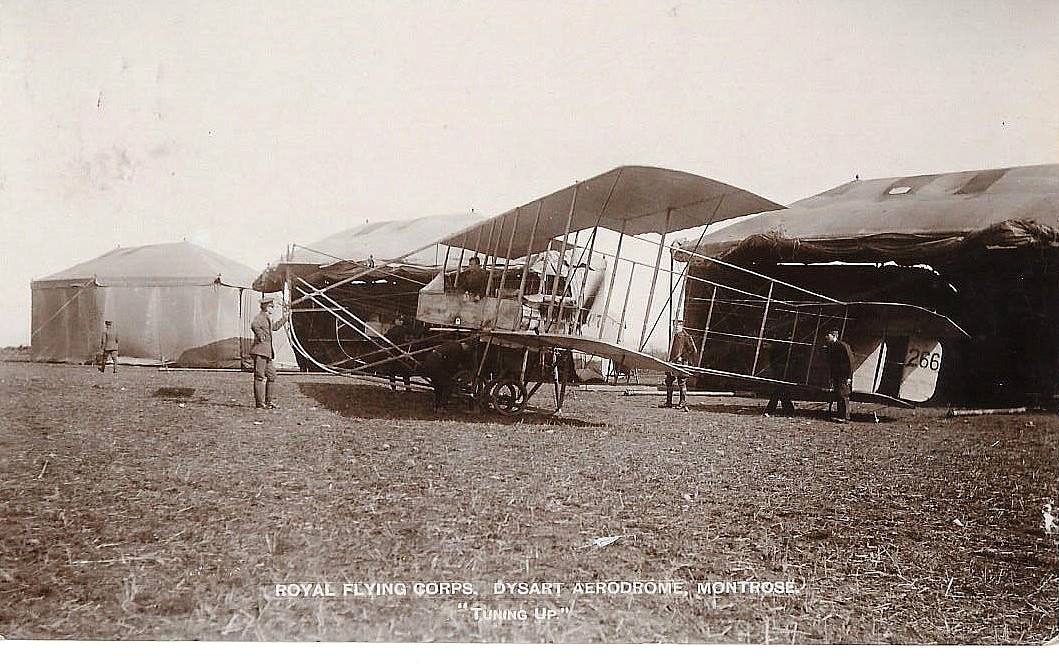Upper Dysart
UPPER DYSART: Military aerodrome
Operated by: Royal Flying Corps
Location: Just N of the A92, about 3nm SW of Montrose town centre
Period of operation: 1913 to 1914
A MICHAEL T HOLDER GALLERY
We have Mike Holder, a great friend of this 'Guide', to thank for providing the following items. It certainly goes to dispel the commonly held myth that the Royal Naval Air Station at MONTROSE was the first military aerodrome in Scotland.
Article One is from Discovering Angus and The Means by I.A.N. Henderson. I find this article very interesting, and as is so often the case, the problem is in defining what exactly is an aerodrome? Having researched the subject for over twenty five years, I now have my own definition. Basically it is the establishment of a facility which has the means to operate several aircraft, with multiple landing runs, and, accommodation for the people based and working there. But, not neccessarily living there.
It must also have facilities for storing and repairing aircraft, refuelling and sundry other capabilities neccessary for the continuation of such activities on a daily basis, including administration, catering and so on. However, as in this case, it does not require permanent buildings.
The author also makes reference to other aerodromes being required for the first aircraft that flew up from FARNBOROUGH. There were none! Instead nominated Landing Grounds were used. These would have been for very temporary use, even if used from time to time, with no facilities at all on site. In this case, for military use, motor transport would arrive in advance carrying pretty much everything envisaged to be needed.
Photo One and Two are from the Upper Dysart web site. The photo of Capt. Beck arriving is from Wikipedia. The aircraft, serial No.266 is a Farman MF.7.
THREE EXCERPTS from Scottish Aerodromes of the WW1 by Malcolm Fife.
SOME NEWS
The article was published in the Dundee Evening Telegraph on the 26th February 1913.
THE FIRST AEROPLANE ARRIVES?
The first and second pictures are from the Upper Dysart web site. I would rather doubt that the first picture, heavily touched up, was taken of the first arrival.
Aircraft in those days needed to land into wind, so it seems to me at least, rather unlikely that a photographer would have been able to predict, in advance, exactly where to position himself this close? In those days, especially for jobs like this, photographers were virtually always men.
The second picture, which was very common practice in those days, was to construct a composite picture. The clue here being that nobody on the ground was looking up at the aircraft. In those days the term aircraft was unknown. I could well be mistaken, but I think it is an American term, along with 'airfield'. Instead the most common term in the early days was 'machine', although the French term 'aeroplane' was becoming more popular.
The third picture was obtained from Wikipedia.
LAST, (BUT CERTAINLY NOT LEAST?)
The painting was published in Scottish Aerodromes of the WW1 by Malcolm Fife. The local area view is from my Google Earth © derived database.
The Notice was published in the Dundee Courier on the 11th December 1913.
A PERSONAL COMMENT
When I was a lad, moving next to what was then London Air Port, now HEATHROW, I was filled with enthusiasm for the most modern aircraft. Books about the earliest 'machines' were incredibly boring. It took many years, to some extent after I had learnt to fly, to slowly become more and more interested in those pioneers of early powered aviation.
It's probably an 'age' thing, when as you get older, history becomes of increasing interest. And indeed, largely the inspiration for starting this project about a quarter of a century ago. Just last year, (in 2023), I boarded a British Airways Airbus at HEATHROW for a holiday in Scotland, landing at Aberdeen just an hour or so later. Totally uneventful as expected.
But, in the back of my mind, now having some knowledge, able to envisage just what an expedition, challenge and adventure flying from FARNBOROUGH to UPPER DYSART must have been. Indeed, as far as I am aware, the longest aerial voyage the Royal Flying Corps had ever undertaken. This was still in an era when the majority of pilots rarely ventured very far from their home aerodrome. Hardly anything was known about how aeroplanes actually flew, except that they could be flown. Instrumentation was minimal, navigation still in its infancy, engines unreliable, and airframes of questionable strength and durabilty.
Individual civilian pilots were of course already touring the country giving 'exhibitions of flying' and becoming very famous for their exploits. Rightly so. But, to move a squadron, or at least part of a squadron from Hampshire to Angus in early 1913, must surely be both applauded and recognised. Sadly it would seem, their endeavours today, in this instance at least, barely get a mention in popular terms.
We'd love to hear from you, so please scroll down to leave a comment!
Leave a comment ...
Copyright (c) UK Airfield Guide




































